
Video Upload Options
In mathematics, a de Rham curve is a certain type of fractal curve named in honor of Georges de Rham. The Cantor function, Cesàro curve, Minkowski's question mark function, the Lévy C curve, the blancmange curve and the Koch curve are all special cases of the general de Rham curve.
1. Construction
Consider some complete metric space [math]\displaystyle{ (M,d) }[/math] (generally [math]\displaystyle{ \mathbb{R} }[/math]2 with the usual euclidean distance), and a pair of contracting maps on M:
- [math]\displaystyle{ d_0:\ M \to M }[/math]
- [math]\displaystyle{ d_1:\ M \to M. }[/math]
By the Banach fixed point theorem, these have fixed points [math]\displaystyle{ p_0 }[/math] and [math]\displaystyle{ p_1 }[/math] respectively. Let x be a real number in the interval [math]\displaystyle{ [0,1] }[/math], having binary expansion
- [math]\displaystyle{ x = \sum_{k=1}^\infty \frac{b_k}{2^k}, }[/math]
where each [math]\displaystyle{ b_k }[/math] is 0 or 1. Consider the map
- [math]\displaystyle{ c_x:\ M \to M }[/math]
defined by
- [math]\displaystyle{ c_x = d_{b_1} \circ d_{b_2} \circ \cdots \circ d_{b_k} \circ \cdots, }[/math]
where [math]\displaystyle{ \circ }[/math] denotes function composition. It can be shown that each [math]\displaystyle{ c_x }[/math] will map the common basin of attraction of [math]\displaystyle{ d_0 }[/math] and [math]\displaystyle{ d_1 }[/math] to a single point [math]\displaystyle{ p_x }[/math] in [math]\displaystyle{ M }[/math]. The collection of points [math]\displaystyle{ p_x }[/math], parameterized by a single real parameter x, is known as the de Rham curve.
2. Continuity Condition
When the fixed points are paired such that
- [math]\displaystyle{ d_0(p_1) = d_1(p_0) }[/math]
then it may be shown that the resulting curve [math]\displaystyle{ p_x }[/math] is a continuous function of x. When the curve is continuous, it is not in general differentiable.
In the remaining of this page, we will assume the curves are continuous.
3. Properties
De Rham curves are by construction self-similar, since
- [math]\displaystyle{ p(x)=d_0(p(2x)) }[/math] for [math]\displaystyle{ x \in [0, 1/2] }[/math] and
- [math]\displaystyle{ p(x)=d_1(p(2x-1)) }[/math] for [math]\displaystyle{ x \in [1/2, 1]. }[/math]
The self-symmetries of all of the de Rham curves are given by the monoid that describes the symmetries of the infinite binary tree or Cantor set. This so-called period-doubling monoid is a subset of the modular group.
The image of the curve, i.e. the set of points [math]\displaystyle{ \{p(x), x \in [0,1]\} }[/math], can be obtained by an Iterated function system using the set of contraction mappings [math]\displaystyle{ \{d_0,\ d_1\} }[/math]. But the result of an iterated function system with two contraction mappings is a de Rham curve if and only if the contraction mappings satisfy the continuity condition.
4. Classification and Examples
4.1. Cesàro Curves
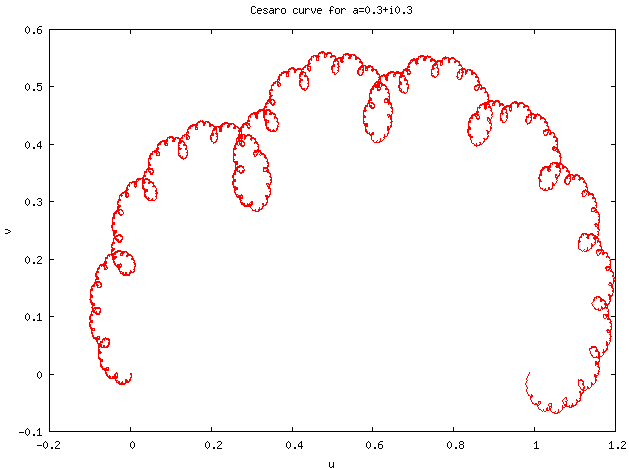
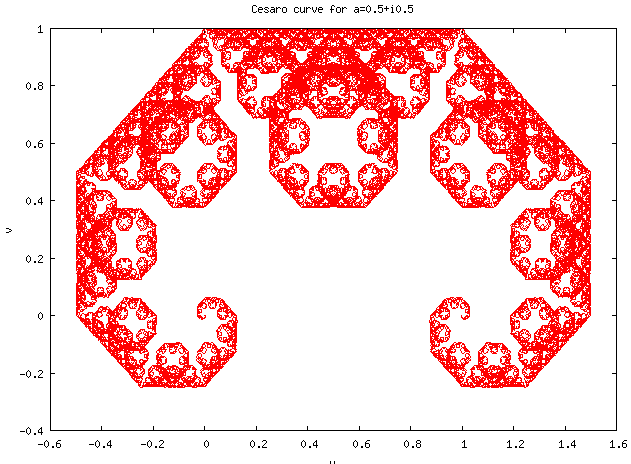
Cesàro curves (or Cesàro-Faber curves) are De Rham curves generated by affine transformations conserving orientation, with fixed points [math]\displaystyle{ p_0=0 }[/math] and [math]\displaystyle{ p_1=1 }[/math].
Because of these constraints, Cesàro curves are uniquely determined by a complex number [math]\displaystyle{ a }[/math] such that [math]\displaystyle{ |a|\lt 1 }[/math] and [math]\displaystyle{ |1-a|\lt 1 }[/math].
The contraction mappings [math]\displaystyle{ d_0 }[/math] and [math]\displaystyle{ d_1 }[/math] are then defined as complex functions in the complex plane by:
- [math]\displaystyle{ d_0(z) = az }[/math]
- [math]\displaystyle{ d_1(z) = a + (1-a)z. }[/math]
For the value of [math]\displaystyle{ a=(1+i)/2 }[/math], the resulting curve is the Lévy C curve.
4.2. Koch–Peano Curves
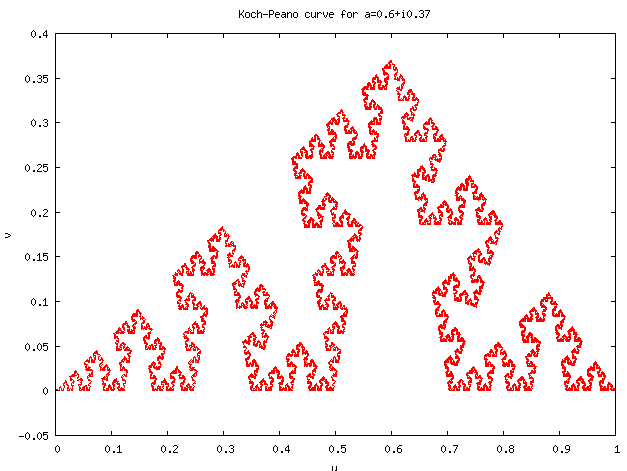

In a similar way, we can define the Koch–Peano family of curves as the set of De Rham curves generated by affine transformations reversing orientation, with fixed points [math]\displaystyle{ p_0=0 }[/math] and [math]\displaystyle{ p_1=1 }[/math].
These mappings are expressed in the complex plane as a function of [math]\displaystyle{ \overline{z} }[/math], the complex conjugate of [math]\displaystyle{ z }[/math]:
- [math]\displaystyle{ d_0(z) = a\overline{z} }[/math]
- [math]\displaystyle{ d_1(z) = a + (1-a)\overline{z}. }[/math]
The name of the family comes from its two most famous members. The Koch curve is obtained by setting:
- [math]\displaystyle{ a_\text{Koch}=\frac{1}{2} + i\frac{\sqrt{3}}{6}, }[/math]
while the Peano curve corresponds to:
- [math]\displaystyle{ a_\text{Peano}=\frac{(1+i)}{2}. }[/math]
4.3. General Affine Maps
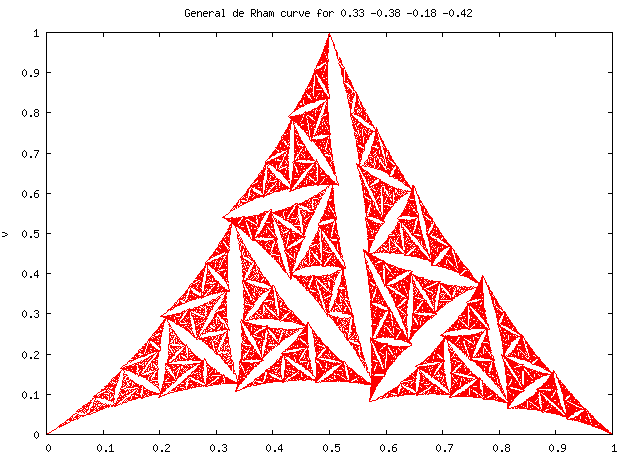
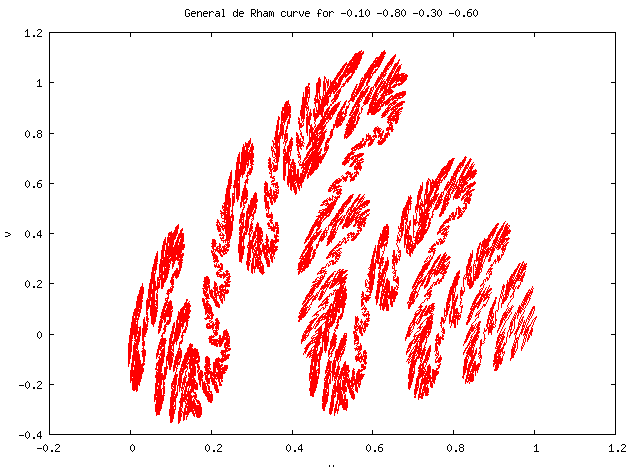
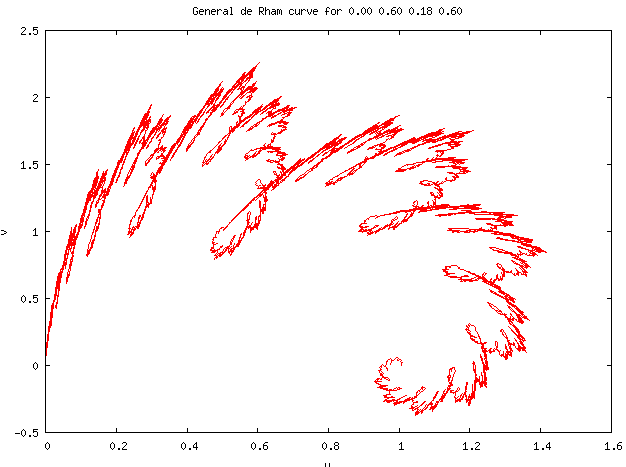

The Cesàro-Faber and Peano-Koch curves are both special cases of the general case of a pair of affine linear transformations on the complex plane. By fixing one endpoint of the curve at 0 and the other at one, the general case is obtained by iterating on the two transforms
- [math]\displaystyle{ d_0=\begin{pmatrix} 1 & 0 & 0 \\ 0 & \alpha &\delta \\ 0 & \beta & \epsilon \end{pmatrix} }[/math]
and
- [math]\displaystyle{ d_1=\begin{pmatrix} 1&0&0 \\ \alpha & 1-\alpha&\zeta \\ \beta&-\beta&\eta \end{pmatrix}. }[/math]
Being affine transforms, these transforms act on a point [math]\displaystyle{ (u,v) }[/math] of the 2-D plane by acting on the vector
- [math]\displaystyle{ \begin{pmatrix} 1 \\ u \\ v \end{pmatrix}. }[/math]
The midpoint of the curve can be seen to be located at [math]\displaystyle{ (u,v)=(\alpha,\beta) }[/math]; the other four parameters may be varied to create a large variety of curves.
The blancmange curve of parameter [math]\displaystyle{ w }[/math] can be obtained by setting [math]\displaystyle{ \alpha=\beta=1/2 }[/math], [math]\displaystyle{ \delta=\zeta=0 }[/math] and [math]\displaystyle{ \epsilon=\eta=w }[/math]. That is:
- [math]\displaystyle{ d_0=\begin{pmatrix} 1&0&0 \\ 0 & 1/2&0 \\ 0&1/2&w \end{pmatrix} }[/math]
and
- [math]\displaystyle{ d_1=\begin{pmatrix} 1&0&0 \\ 1/2 & 1/2&0 \\ 1/2&-1/2&w \end{pmatrix}. }[/math]
Since the blancmange curve of parameter [math]\displaystyle{ w=1/4 }[/math] is the parabola of equation [math]\displaystyle{ f(x)=4x(1-x) }[/math], this illustrate the fact that in some occasion, de Rham curves can be smooth.
4.4. Minkowski's Question Mark Function
Minkowski's question mark function is generated by the pair of maps
- [math]\displaystyle{ d_0(z) = \frac{z}{z+1} }[/math]
and
- [math]\displaystyle{ d_1(z)= \frac{1}{z+1}. }[/math]
5. Generalizations
It is easy to generalize the definition by using more than two contraction mappings. If one uses n mappings, then the n-ary decomposition of x has to be used instead of the binary expansion of real numbers. The continuity condition has to be generalized in:
- [math]\displaystyle{ d_i(p_{(n-1)})=d_{(i+1)}(p_0) }[/math], for [math]\displaystyle{ i=0 \ldots n-2. }[/math]
Such a generalization allows, for example, to produce the Sierpiński arrowhead curve (whose image is the Sierpiński triangle), by using the contraction mappings of an iterated function system that produces the Sierpiński triangle.




